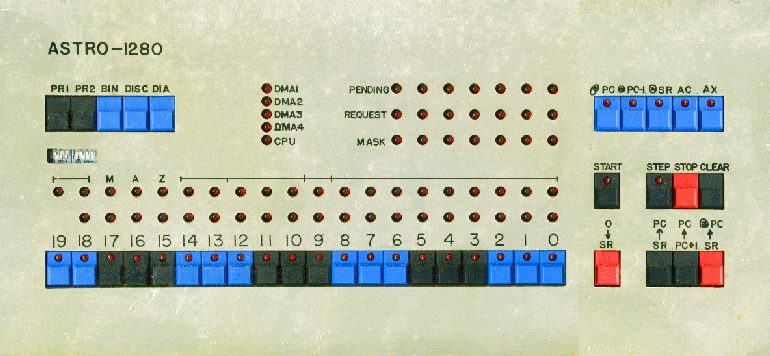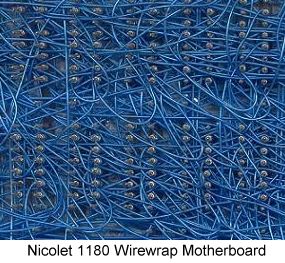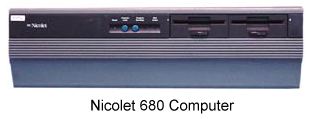The Nicolet 1080 evolves.
The magnetic core memory of the Nicolet 1080 was rapidly obsoleted by a new
technology—semiconductor memory. It was faster, smaller, cheaper and it used less
power. There was no good way to retrofit the 1080 with semiconductor memory so it was
replaced. The new computer, called an 1180, would have used a 2048 bit, P-MOS part. (We
knew the first 1024 bit parts from Intel were very cantankerous.) We accidentally smoked
the prototype 1180 but that turned out to be a very good thing because the P-MOS part was
already obsolete. We switched to a Mostek 4096 bit CMOS part which worked very well. The
1180 was the first computer in the world to work reliably with CMOS DRAMs. Hewlett Packard
is usually given credit for this, but we beat them by two months. Virtually all modern
computers use CMOS DRAM, but now the number of bits per chip has 6 more digits.
The 1180 computer still had vestiges of the hardwired signal averager. These took the form
of computer readable switches. But the 1180 had a prioritized direct access memory scheme
that allowed the computer, the hard drive and the analog to digital converter to operate
concurrently in the same memory. The 1180 was not the two faced monstrosity its
predecessor was.
The 1180 computer had a 7 level, vectored, prioritized interrupt system. Multi-tasking was
now possible. The 1180 was an advance over the 1080, yet it was not well thought out and
it was hard to manufacture and service.
The Nicolet 1180 evolves.
The Nicolet 1180 was improved and updated in 1978. The result, the Nicolet 1280, now looks like a computer, with no vestiges of its hard wired program forbears. (Don't ask why this hand lettered front panel says ASTRO-1280.) It is possible to convert this 1280 into a hexadecimal machine by rearranging the plastic key caps. (It happened.)

I argued, and lost, the case for a 24 bit 1280.
 The 1280 was easy to service and
manufacture and, in general, better thought out. The mother board was a printed circuit
with no active components on it. The 1280's predecessors had wire wrapped mother boards
which were very expensive. The only wires in the 1280 were between the motherboard and the
power supply. The memory board, the CPU board, the front panel, the hard drive interface
board, etc. could be plugged into any slot. The front panel board could be replaced by a
dummy with only a start and stop button. Bootstraps and diagnostics were built in. Turnkey
application software was stored in ROM in many cases. Now, end users could forget about
the computer.
The 1280 was easy to service and
manufacture and, in general, better thought out. The mother board was a printed circuit
with no active components on it. The 1280's predecessors had wire wrapped mother boards
which were very expensive. The only wires in the 1280 were between the motherboard and the
power supply. The memory board, the CPU board, the front panel, the hard drive interface
board, etc. could be plugged into any slot. The front panel board could be replaced by a
dummy with only a start and stop button. Bootstraps and diagnostics were built in. Turnkey
application software was stored in ROM in many cases. Now, end users could forget about
the computer.
The twinkle lights were very useful to programmers. If an interrupt request wasn't being
honored, you could see it. If an interrupt service request (ISR) did not restore properly,
you would see the "pending" led go on.
The 1280 had raster graphics, like a modern PC. It was an industry first. The graphics
card had a specialized graphics processor that converted x-y data into pixels. There was a
character generator that could write characters to pixels. Pixels could be scrolled in any
direction. Different kinds of graphical information could be dynamically displayed without
taxing the CPU. This included waterfall displays. The large, dynamic and colorful display
made a big impression at trade shows.
 It seems programmers love computer games and the new 1280 raster graphics
provided new opportunities. Pacman was popular at the time. A version of it was written
for the 1280. It involved a yellow munching thing which, in this case, was implemented
with a ISR. During a demonstration at a trade show, the yellow munching thing was
accidentally released by unmasking an interrupt. It munched its way slowly through a
potential customer's spectrum. An alert salesman pointed out the 1280's multitasking
capabilities. Things can go wrong in bizarre ways.
It seems programmers love computer games and the new 1280 raster graphics
provided new opportunities. Pacman was popular at the time. A version of it was written
for the 1280. It involved a yellow munching thing which, in this case, was implemented
with a ISR. During a demonstration at a trade show, the yellow munching thing was
accidentally released by unmasking an interrupt. It munched its way slowly through a
potential customer's spectrum. An alert salesman pointed out the 1280's multitasking
capabilities. Things can go wrong in bizarre ways.
The papertape reader was replaced by an 8 inch floppy. Winchester hard drives became
available. They held an unbelievable 50 megabytes on 8 inch disks and they cost under a
thousand dollars!
The Nicolet 1280 evolves.
 The Nicolet 1280 lost its twinkle lights in 1986. The 1280 CPU was condensed to two boards, thanks to
the new, dense memory chips. A switching power supply, two 3.5 inch drives and four 10 by 15 inch
boards were packaged in this svelte box. It looked like a contemporary PC but it had much better performance.
The Nicolet 1280 lost its twinkle lights in 1986. The 1280 CPU was condensed to two boards, thanks to
the new, dense memory chips. A switching power supply, two 3.5 inch drives and four 10 by 15 inch
boards were packaged in this svelte box. It looked like a contemporary PC but it had much better performance.
Eventually, the 1280 CPU was reduced to a gate array. To do this, the entire 1280 had to be described by Boolean equations. Mike Lennon wrote the equations and got it right on the first go. Now, a complete system could be condensed to a single board. The external appearance of the computer did not change, but the computer got faster, smaller and cheaper and it consumed less power.
The Nicolet 20 bit computer went extinct in 1996, partly because customers demanded IBM PCs, partly because programmers refused to write Nicolet assembly language and partly because Nicolet computers do not play well with other computers. But, the Nicolet computer did have a 25 year run which is not bad.
The number of sales of various Nicolet computers
• About 100 Nicolet 1070/PDP-8s were sold.
• About 270 Nicolet 1080s were sold, including the OEM version.
• About 1,010 Nicolet 1180s were sold.
• About 1,895 Nicolet 1280s were sold.
• About 3,010 Nicolet 620/680s were sold, mostly embedded in Nicolet FTIR systems.
Many contributed to the development of Nicolet computers, but it would be impossible to
overstate the contributions of Dick Ferrier. Dick was a day person and I was a night
person. When we worked together on the same project, there would be an hour of overlap or
maybe none. The project moved continuously forward almost 24 hours a day.
Many contributed to the development of Nicolet software. The quality of Nicolet
application software was often the key to success. Users of Nicolet spectrometers were
chemists and so it made sense to have chemists write applications software. Dave
Dalrymple, a PhD chemist, wrote an amazing amount of application software in assembly
language.
Don Parker wrote a Fortran Compiler by himself. It was real. It could pass the FORTRAN77
validation suite. He too was a chemist.
A note about Moore's Law
Gordon Moore, cofounder of Intel, predicted the number of transistors on a chip would double every 2 years. That prediction has proven accurate beginning in 1965 to the present day, 2009. It seems to work for CPUs, semiconductor memory and magnetic memory.
Nicolet's first Fourier machine, the 1070/PDP-8, required an hour to calculate a 4k FFT. Nicolet's last Fourier machine, the 680 with a FFT coprocessor, required less than a second to calculate a 4k FFT. This works out to a doubling of speed every 2 years for 24 years, seeming to confirm Moore's Law.
Moore's law seems to work on the price of semiconductor fabs too. The price of doubling the number of transistors on a chip doubles every two years. The productivity of new fabs increases but the the number of fabs decreases. I predict Moore's Law will fail when the number of fabs reaches one.
Actually, Moore's law does not predict computer performance. In fact, computer designers are not able to make good use of all those transistors. Doubling the number of transistors only gets a 20 percent increase in performance, it seems.
A note about Moore's Law Compensator
Moore's Law Compensator is less well known. It states that bloatware, operating system "advances" and antivirus software cancel any computer performance improvements due to Moore's Law.